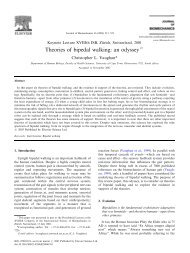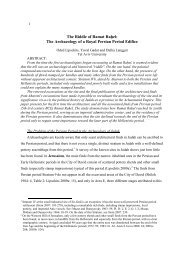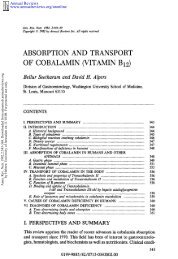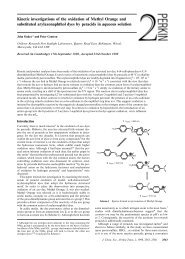The Cemetery of Azor and Early Iron Age Burial Practices
The Cemetery of Azor and Early Iron Age Burial Practices
The Cemetery of Azor and Early Iron Age Burial Practices
You also want an ePaper? Increase the reach of your titles
YUMPU automatically turns print PDFs into web optimized ePapers that Google loves.
Ben-Shlomo<strong>The</strong> <strong>Cemetery</strong> <strong>of</strong> <strong>Azor</strong>Table 1Phasing sequence <strong>of</strong> <strong>Azor</strong>, Area DPhase Period DescriptionI Islamic (Mamluk/Ottoman?) Cist tombs, other burials, wallsII <strong>Iron</strong> <strong>Age</strong> IIB–C Possible burials, pottery remainsIII <strong>Iron</strong> <strong>Age</strong> IIA Pit burials, multiple burials (at least two phases)IV <strong>Iron</strong> <strong>Age</strong> I Pit burials, jar burials, cremation burialsV <strong>Iron</strong> <strong>Age</strong> I Brick-case tombsVI Late Bronze <strong>Age</strong> Pottery <strong>and</strong> few disturbed burialsTwo 5 6 5 m squares were excavated during the 1958season (Fig. 2: Sqs M9 <strong>and</strong> M10) adjacent to thenorth-eastern side <strong>of</strong> the hill, <strong>and</strong> three additionalsquares were excavated during 1960 (Fig. 2: Sqs J10,K10 <strong>and</strong> L10; Dothan 1961a, fig. 1). <strong>The</strong> excavationwas limited by the presence <strong>of</strong> a modern Muslimcemetery nearby (Dothan 1989, 163), mainly on thesouthern part <strong>of</strong> the hill, <strong>and</strong> penetrated about 3 . 0mdeep into the ground.<strong>The</strong> <strong>Iron</strong> <strong>Age</strong> graves can be divided betweenthree phases: Phases III, IV <strong>and</strong> V. Phase V burialsunderlie the Phases III–IV burials in several places,while the designation <strong>of</strong> burials to either Phases III orIV was done <strong>of</strong>ten according to the date <strong>of</strong> thepottery from the burials. Phases III <strong>and</strong> IV–Vrepresent two distinct pottery assemblages, whichcould be dated respectively to the <strong>Iron</strong> IIA <strong>and</strong> thelate <strong>Iron</strong> I. Phases IV–V are marked by PhilistineBichrome, degenerated Philistine forms <strong>and</strong> redslippedvessels. <strong>The</strong> later assemblage is markedby Cypro-Phoenician (mostly ‘Black on Red’juglets) <strong>and</strong> local ‘black’ juglets (see below). Scanty<strong>Iron</strong> IIB may represent burials from this period(Phase II).At least 50 <strong>Iron</strong> <strong>Age</strong> graves were identified(Table 2) <strong>and</strong> these can be classified into six generalcategories (Fig. 3):1. Simple pit burials with usually one individual,seldom two. According to the better-preservedexamples the burial was primary <strong>and</strong> the positionsupine. <strong>The</strong>se burials are the most common typenumbering more than 30 burials. In many cases thepit was not detected <strong>and</strong> the concentration <strong>of</strong> skeletalremains <strong>and</strong> artefacts is the sole feature defining theburial, which is thence assumed to be a pit grave. Atleast 16 burials could be dated to the <strong>Iron</strong> I (PhaseIV), many are relatively well preserved. Of the betterpreserved pit burials <strong>Burial</strong> D24 (Fig. 4; Dothan1961d, 82, fig. 2) had an articulated supine skeletonwith the head to the west; the skull was somewhatraised <strong>and</strong> turned to the south. A similar position <strong>of</strong>the skull can be seen in a LBIIB–<strong>Iron</strong> <strong>Age</strong> I pit gravefrom the IAA excavations nearby (Buchennino 2006,fig. 1). <strong>The</strong> skull was found to be <strong>of</strong> a female youth(Ferembach 1961, 86). 2 On the waist a large carinatedbowl was placed upside down (Fig. 18:2); the burialalso contained another similar carinated bowl, a flask(Fig. 18:12) <strong>and</strong> a pyxis, both intact, which wereplaced near the right h<strong>and</strong> <strong>of</strong> the body. <strong>The</strong>re areFigure 3Area D with Phase IV graves2 Most <strong>of</strong> the remarks relating to the human remains are based on notesthat were taken by anthropologists N. Haas <strong>and</strong> H. Nathan upon initialinspection <strong>of</strong> the bones (Dothan 1961a, 11; Dothan <strong>and</strong> Dothan 1992,112–13), as well as to another publication <strong>of</strong> several skulls (Ferembach1961), <strong>and</strong> a recent report by Y. Nagar <strong>of</strong> the IAA. <strong>The</strong> terms relating to thealleged skull types should be taken with much reservation.Levant 2008 VOL 40 NO 1 31







